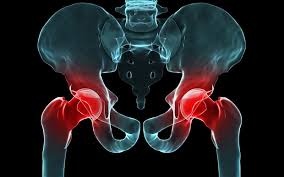Why cheap NHS hip implants are leaving thousands in crippling pain
Thanks to his two hip replacements — one off-the-shelf, the other custom-made — Jason Mottram is an unusual walking case study.
And for the 170,000 NHS patients who will undergo hip and knee replacement surgery in the next 12 months, his is a cautionary tale of two joints.
Eight years ago, just before his 38th birthday, Jason’s left hip joint was fixed with a standard, off-the-shelf implant like those routinely used in the NHS.
‘I’d had little niggles for a few years but that summer it suddenly came to a head,’ says Jason, 45, from Loughton, Essex.
Playing tennis once or twice a week, he started to feel a sharp pain at the front of his thigh, which he first dismissed as groin strain.
When the keen amateur footballer, squash and tennis player finally went to a doctor, he was shocked to be diagnosed with osteoarthritis, a disease associated with much older people.
‘I was told I was unfortunate, but I had played a lot of the sports that put the most pressure on the hip joints,’ he says.
Determined not to miss out on kicking a ball around with his sons Sam and Luke, then five and three, Jason opted to have a hip replacement.
But to his consternation, it left him with one leg 1.5cm shorter than the other.
He endured a year of pain and limited mobility as his body struggled to adjust to an implant that, as he later discovered, bore little resemblance to the anatomy of his original hip.
The imbalance was caused mainly by the incorrect length and angle of the implant shaft inserted into his thigh bone.
The discrepancy was ‘really dramatic’, he says. ‘I really struggled with it. I had to get all of my shoes and trainers adjusted with inserts because I was literally lopsided.’
Six years later, Jason’s other hip had deteriorated to the point where it too had to be replaced. But this time, the City accountant’s company health insurance paid for a bespoke implant.
Using made-to-measure components built with 3D templates generated by a CT scan of his hip, the replacement replicated his original anatomy to within 2-3mm.
The difference between the two implants ‘was like night and day’.
‘It was about a year before my body had adjusted to the first operation; this time I was back playing tennis after just six weeks,’ he says.
The surgeons who use made-to-measure hip and knee implants say they are much better than the cheaper, off-the-shelf versions and claim many NHS patients could be living with pain and reduced mobility unnecessarily.
At anything from £4,000 to £6,000 for a hip joint and about £3,000 for a replacement knee, custom-made implants cost at least twice as much as off-the-peg versions.
But the cheaper implants could be costing the NHS more money in the long term, the surgeons say.
Custom-made replacements are ‘significantly better than a standard, off-the-shelf prosthesis’ and are likely to last longer, so fewer patients will need early ‘repeat’ surgery, argues Ian McDermott, a consultant orthopaedic surgeon at the London Sports Orthopaedics practice.
Because there is less bone left to work with second time around, repeat surgery is always more challenging than the original operation and expensive for the NHS.
The benefits of a custom-made implant are perhaps even more pronounced when it comes to the knee, a more complex joint, says Henry Atkinson, a consultant orthopaedic surgeon at North Middlesex University Hospital trust who also carries out the replacements in the private sector.
Most knee implant systems ‘have only five or six sizes and very few peoples’ knee anatomy will truly be matched’ he says. ‘It’s a bit like having only one shoe design with only five or six sizes in a shoe shop.’
It’s a similar story with hips and Mr Atkinson says he is frustrated by the limited sizes available to him when operating on NHS patients, ‘particularly when I can see the differences in patient clinical outcomes with my own eyes’.
The NHS uses very few bespoke hip and knee implants and only then in patients with unusual anatomy.
The great majority have a hip and thigh bone within the ‘normal’ range, says Mark Wilkinson, a spokesperson for Arthritis Research UK and professor of orthopaedics at the University of Sheffield.
The results, he says, ‘are extremely good, with 90 per cent or more of people finding that their pain is greatly reduced’.
But this is an unduly positive take on the statistics, says Paul Jairaj, the London surgeon who gave Jason Mottram his tailor-made hip.
The most recent official figures, published in May, show that more than one in ten patients who underwent a hip replacement in the last year felt their general health had either not improved or had worsened after surgery.
For knee surgery it was worse, with 20 per cent dissatisfied.
In fact, says Henry Atkinson, there is extensive evidence that many patients continue to suffer pain after standard hip and knee surgery.
Official figures published in May last year show that one in five patients who underwent knee surgery in the last year felt their general health had either not improved or had worsened
A study published in the journal Pain in 2011 found that three to four years after surgery 44 per cent of 632 knee and 662 hip patients reported persistent pain.
For 15 per cent of knee and 6 per cent of hip patients the pain was ‘severe to extreme’.
Furthermore, research has found that ‘a large proportion of patients have some sort of imbalance or size mismatch with their knee replacements’, says Mr Atkinson.
Private surgeon Paul Jairaj says his NHS colleagues can only do so much with the limited range of standard sizes at their disposal.
‘You can more or less match somewhere in the order of up to 85 per cent of patients with a standard implant but for 15 per cent or more there is just no way an off-the-shelf implant is going to fit them properly.’
Research has found that ‘many patients have some sort of size mismatch with their knee replacements'
And many patients, he believes, aren’t even getting the off-the-shelf implant best suited to them.
He and his colleagues use digital 3D scanning to accurately measure the dimensions of a patient’s original hip — something that could also be used to select the correct off-the-peg implant but which simply doesn’t happen on the NHS because of the cost.
Instead at best only two-dimensional ‘templating’ is carried out, by overlaying a transparent image of the implant over an X-ray of the patient’s joint — and sometimes, he says, surgeons rely only on their experience to estimate the right size of implant required.
A private hospital would charge anything from £250 to £700 for a CT scan. Mr Jairaj says it might be worth paying to have a scan privately, but only if your NHS surgeon is trained to use it — check first.
Now even the limited range of standard implants available to NHS surgeons is being squeezed further, says Ian McDermott; this potentially means many more patients could be struggling with the sort of difficulties experienced by Jason Mottram.
As Mr McDermott explains, there has been ‘a massive move recently within the NHS to restrict consultants’ choice and to force them to use the cheapest possible hip and knee prostheses’.
A review of orthopaedic services published in March last year concluded that the NHS is facing a ‘perfect storm’ of ever rising demand and financial austerity.
In 2006 there were 60,000 hip replacements carried out in England, Wales and Northern Ireland. By 2014 it had risen to 88,763 (there were 57,000 knee replacements in 2006 and 87,500 in 2014).
While ‘we have a responsibility to make the best clinical choices for our patients,’ the review said, ‘we also have a moral responsibility to ensure that our decisions . . . allow for the less expensive of two equally good options to be our standard preference on all occasions’.
Tim Wilton, president of the British Orthopaedic Association, told Good Health there were ‘no grounds for any concern’ and ‘no compelling evidence that bespoke implants are better for patients’.
The association, he added, is currently working with the Department of Health on a drive to cut costs in orthopaedic surgery, encouraging surgeons to choose the implants used ‘more wisely’, which is ‘better for both individual patients and the NHS budget’.
DO YOU NEED A NEW HIP?
It might be necessary for you to have a hip replacement if one (or both) of your hip joints becomes damaged and causes you persistent pain or problems with everyday activities such as walking, driving and getting dressed.
It might be necessary for you to have a hip replacement if your hip damage causes you persistent pain
Some common reasons why a hip joint can become damaged include:
- Osteoarthritis – so-called "wear and tear arthritis", where the cartilage inside a hip joint becomes worn away, leading to the bones rubbing against each other
- Rheumatoid arthritis – this is caused by the immune system (the body’s defence against infection) mistakenly attacking the lining of the joint, resulting in pain and stiffness
- Hip fracture – if a hip joint becomes severely damaged during a fall or similar accident it may be necessary to replace it
But increasingly this is going to mean ‘hospitals are going down to one supplier of hips and knees in order to reduce their costs, whereas perhaps five years ago it was whatever a surgeon chose’, according to William Bartlett, a consultant orthopaedic and trauma surgeon who sees patients privately and for the NHS at at the Whittington Hospital, London.
Mr Bartlett fears that soon there could be a single NHS hip replacement — ‘the worry is that we could find we are taking a retrograde step in terms of using prostheses which for various reasons are unattractive to use — but are cheaper’.
But Tim Wilton insists there will be ‘no trade off, and surgeons will retain control over the implants they use, which will normally be standard implants that often deliver the best results for a lower cost’.
Jason Mottram is thankful that his insurance paid out for a made-to-measure hip.
It was only when he came to have the second hip treated did he learn that the size and positioning of his first replacement joint had borne little resemblance to the one it was replacing, and that ‘the pain I suffered in that first year was my ligaments and muscles adjusting to the alien positioning of the new joint’.
‘I’ve seen the difference between the two procedures,’ he says. ‘It’s true I was better as a result of my first operation, and if it was the only possible procedure it would still be worth having.
'But it isn’t. There’s something so much better out there and it’s a shame it isn’t available to all.'
1385290577.jpeg)






Comments
Comment 1If I was someone going for a hip replacement, I would be extremely nervous and asking lots of questions after reading this disturbing article. It is obvious people should be contributing more to the NHS to keep things improving, not going backwards, as this article suggests. But I wonder whether the population is aware of how exactly cut backs are affecting their care? I am extremely lucky to have benefited 100% from having hip resurfacing. I was in such pain and mobility was difficult as I was going around on crutches before the procedure and now my life is back to how it was before all the pain started. Interestingly, I had a slight difference in leg height and after the operation, leg lengths are the same.